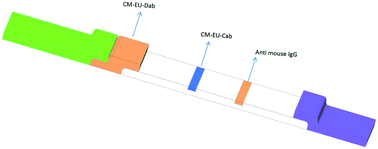A novel time-resolved fluorescent lateral flow immunoassay for quantitative detection of the trauma brain injury biomarker-glial fibrillary acidic protein†
Abstract
A highly sensitive time-resolved fluorescence lateral flow immunoassay (TRF-LFIA) was developed to quantify glial fibrillary acidic protein (GFAP), a trauma brain injury (TBI) biomarker in blood, for the purpose of providing a diagnosis of mild brain injury. The assay detection limit was 10 pg mL−1 with a diagnostics range of 0–400 pg mL−1. The assay coefficients of variation (CoVs) were less than 10%. Availability of the TRF-LFIA for blood testing would produce a paradigm shift in TBI patient management and clinical outcomes in trauma departments. Due to its capacity to measure low levels of blood biomarkers in human fluids, this type of assay is expected to find use in the rapid detection of various human disorders.



 Please wait while we load your content...
Please wait while we load your content...